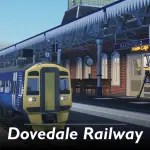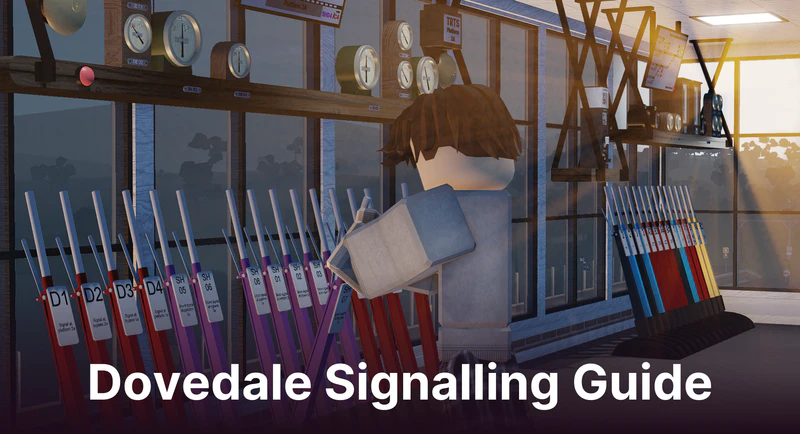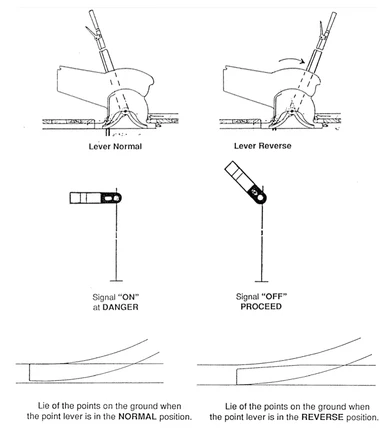Signalling is perhaps one of the most important parts of the railway, and exists to ensure the safety of people, trains, and the surrounding infrastructure. For the most part, this is ensured by having one train, in one section, at one time.
This guide will cover most of what you need to start signalling in Dovedale, however beforehand it is essential that you have read the Signals and Signs pages so you have sufficient knowledge of topics that are covered in this guide.
An Introduction to Signalling
| 1.1 - The History |
|---|
|
Railways in a modern sense started in 1830 with the Liverpool and Manchester Railway. At first there was little need for signals or signalling; trains were rare and travelled at low speeds. However, by the 1840s, a number of accidents occurred, which prompted the introduction of the first railway signalling systems. The first major innovation was time interval working, and was introduced to prevent accidents on the railway alongside fixed signals or hand signallers. The principles of this operation were:
Whilst this was an improvement on the old regime, time interval working was fatally flawed. If a train broke down or came across an obstruction, the next train could crash into it. Prompted again by more accidents, it became clear that a space interval rather than a time interval was required, and thus by the 1850s, the foundation of all modern signalling - Absolute block - was created. |
| 1.2 - The Basics: Block Signalling |
|---|
|
Block signalling is the first principle of all modern signalling systems; the general principle being that there should only be one train, in one section, at one time, with few exceptions. Absolute block came as a result of incidents in the time interval system in the 1850s. It was made mandatory for all railways in 1889 and forms the basis of all modern railway signalling. In fact, there are still many signal boxes working under this methodology today. In principle:
|
Signal Box Equipment
| 2.2 - Electrical Release Plungers |
|---|
|
Some levers have an electric lock plunger connected to them; you will need to press the plunger with the corresponding number before pulling the lever. You do not need to hold the plunger to move the lever back to the normal position. 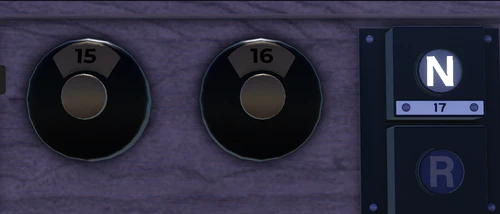 |
| 2.3 - Signal and Points Indicators |
|---|
 All signal boxes contain indicators which display the aspect/position of each signal and set of points controlled by the signal box. This allows the signaller to ensure that signals and points are in the correct position after moving a lever. Mechanically operated signals and points are connected to indicator dials with three positions. For signals, the positions are: 'On' (danger/caution aspect), 'Wrong' and 'Off' (clear aspect). For points: 'Normal', 'Wrong' and 'Reverse'. Electrically operated signals and points are connected to small indicator boxes. Signal indicators will show a small coloured light representing the aspect shown on the signal. Points indicators will display 'N' or 'R' representing Normal and Reverse respectively. Note that if an indicator displays 'Wrong' or does not change state, this means your player has not loaded the physical signal. |
| 2.4 - Track Circuits |
|---|
 In all signal boxes aside from Benyhone Loop Signal Box, the diagram includes numerous pairs of lights, which show the location of trains without the signaller having to look for them. This is particularly useful in signal boxes that lack line of sight with certain areas, as signallers can tell which signals a train a has passed. Aside from being located on the signal box diagram, some track circuit indicators may be attached to or placed on the block shelf, named with the pertaining location or line. An example of one style can be seen below. 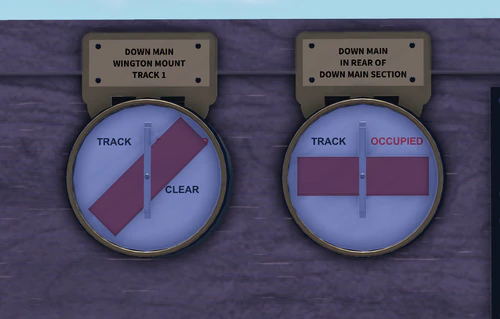 |
| 2.5 - Barrier Pedestals & Gate Wheels |
|---|
|
In most signal boxes, level crossings are operated by a barrier pedestal. The barrier pedestal has a switch in the middle, allowing you to switch between the "raise" and "lower" position. In addition to this pedestal, you will need to unlock the level crossing controls like gate locks and stops before being able to pull the crossing. You must pull the brown lever in the box to do so. Some crossing have "On-call" functionality for them, these level crossing can be kept down until a road user has pressed a plunger which would activate an annunciator on the level crossing control. You then may raise the level crossing. After 3-5 minutes or when needed, the level crossing can then be lowered. Before you can clear any signals over the crossing, you must:
After all trains have passed and it is safe to do so, you should raise the barriers. Marigot Crossing Signal Box is fitted with a gate wheel. The same procedure should be followed, however the gates are operated through the "R" and "F" keys on your keyboard. 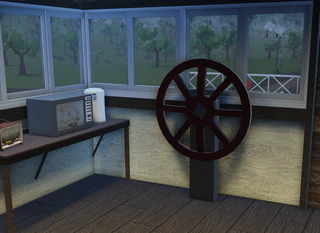 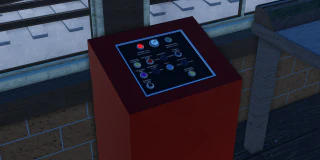 |
Absolute Block Signalling
| 3.1 - The Principles of Absolute Block |
|---|
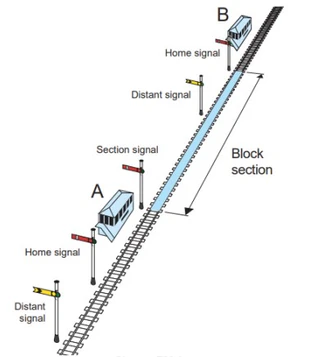 Before a train can enter a block section, the next signal box must give permission for a train to approach. Signallers do this through the use of block instruments and bell signals.
|
| 3.2 - Block Instruments |
|---|
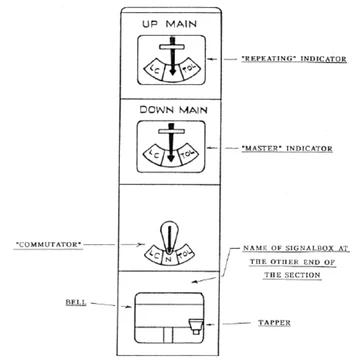
Some block instruments may look different to this standard one, and may be split up into different parts, but they all fundamentally work the same. Block instruments have three states:
When a block instrument is used over a single line, the sending signal box must keep their commutator at normal. |
| 3.3 - Bell Signals |
|---|
|
Bell signals are used to communicate between signal boxes, and are still used today in lieu of telephone communications. Bell codes have distinct advantages over verbal communication, namely:
A full list of bell codes can be found within all signal boxes, however a list of some commonly found ones can be found on the bell codes page. You must acknowledge all bell signals by repeating them. You must not consider any bell signal as understood until it has been correctly acknowledged. You must send call attention (1) and have it acknowledged before you send any other bell signal, except for:
In most boxes, there is more than 1 bell. To differentiate the difference between those, you can click on the metal bell itself to hear the sound. This will not notify the other signaller. |
| 3.4 - Procedure: Offering & Sending Trains |
|---|
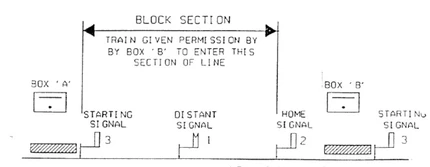 Offering TrainsFor the purposes of this example, you, signaller "A" will be signalling a train from signal box "A" to signal box "B". When sending a train between signal boxes, you must offer it. Before you can offer a train to signaller "B", you must:
To offer a train:
Receiving TrainsFor the purposes of this example, you, signaller "A" will be receiving a train from signal box "B".
|
| 3.5 - Procedure: Opening, Closing & Testing |
|---|
Opening a Signal BoxWhen you open your signal box you must send opening of signal box to all surrounding signal boxes.
Closing a Signal BoxWhen you close your signal box you must:
Testing EquipmentAs soon as possible after opening, if no trains are immediately due to be signalled, you must test your bells and block indicators. Absolute Block Procedure
Electric Token Block Procedure
|
| 3.6 - Procedure: Shunt Into Forward Section |
|---|
|
This regulation must be used when a train needs to pass your last stop signal into the block section for shunting purposes. When sending shunt into forward section, you must:
If you receive shunt into forward section you must:
|
| 3.7 - Procedure: Blocking Back |
|---|
|
This regulation must be used when you must send a train on the wrong direction for shunting purposes. If you're shunting train on the right direction, see shunt into forward section. If you are intending to send Blocking Back, you must:
When you are receiving Blocking Back, you must:
You must not acknowledge blocking back if you have allowed a movement toward the sending signal box which would conflict with the shunting movement at the sending signal box. On a single line, you must use shunting train into forward section instead of blocking back. |
| 3.8 - Procedure: Cancelling & Train Incorrectly Described |
|---|
CancellingIf a train is not going to proceed but you have already sent is line clear or train entering section, you must:
If you receive cancelling (3-5) you must acknowledge it and place your commutator to normal. Train Incorrectly DescribedIf you have sent the incorrect line clear and the signal box in advance has acknowledged it, you must:
If you receive train incorrectly described (5-3), you must acknowledge it and then acknowledge the correct is line clear. Do not move the commutator on the block instrument. |
| 3.9 - Procedure: Obstruction Danger |
|---|
When to SendYou must send obstruction danger if you need to stop trains coming towards your signal box due to an obstruction or other emergency within the block section. You must immediately, and without sending call attention, send obstruction danger (6) to all relevant signal boxes. You must send obstruction danger even if you have not received is line clear or train entering section. You must also send obstruction danger if a train is approaching which you have not:
You do not need to send obstruction danger if you can move facing points to a line that is clear. Sending Obstruction DangerWhen sending obstruction danger (6) you must:
You must then tell all relevant signallers the reason for sending obstruction danger. You must then reach a clear understanding of the lines affected and which can be re-opened for trains. If you receive train or vehicles proceeding without authority in the right direction (4-5-5) after sending obstruction danger, you must take all possible actions to stop the approaching train. If you receive cancelling for a train which has been acknowledged before you sent obstruction danger, you must acknowledge it but keep the block instrument at train on line. Receiving Obstruction DangerIf you receive obstruction danger (6) you must:
If no train has been signalled towards the sending signal box, you must acknowledge obstruction danger. If you cannot stop a train heading towards the signal box, or there is already a train in section, you must not acknowledge obstruction danger and immediately send train or vehicles proceeding without authority in the right direction. If you succeed in stopping a train, you must then acknowledge obstruction danger and send cancelling. You must then find out why obstruction danger was sent, and reach a clear understanding of the lines that remain blocked and which can be re-opened for trains. Obstruction RemovedWhen the obstruction has been removed, or if a train can pass clear of the obstruction, you must send call attention followed by obstruction removed (2-1-2) and place your block instrument to normal. However, if there is a train in section you must not send obstruction removed until that train is clear of the section. |
| 3.10 - Procedure: Train or Vehicles Proceeding Without Authority |
|---|
Train or vehicles proceeding without authority in the right direction (4-5-5)If a train or vehicle proceeds without authority in the right direction, you must:
If you receive train or vehicle proceeds without authority in the right direction, you must:
If there is already a train in section, you must:
If there is no train in section you must send train out of section and signal the next train as normal. Train or vehicles proceeding without authority in the wrong direction (2-5-5)If a train or vehicle proceeds without authority in the wrong direction, you must:
If you receive train or vehicle proceeds without authority in the wrong direction, you must:
|
Electric Token Block Signalling
| 4.1 - Tokens and Occupation Keys |
|---|
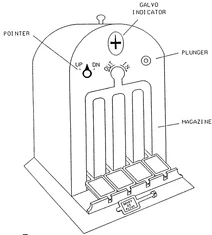 On the line between Benyhone Loop Signal Box and Fanory Mill Signal Box, the Electric Token Block regulations are used to signal trains. Like the Absolute Block regulations seen above, the main principle of the system is to have one train, in one section, at one time. ETB, however, is fundamentally different in that drivers must be in possession of an object, known as a token, to proceed onto the single line block section. Both boxes make use of a Tyer's No.9 Key Token Instrument. These consist of:
When signalling a train using the token instruments, the same procedures must be followed as the absolute block system mentioned above in section 3.1, however:
|
Tokenless Block Signalling
| 5.1 - Tokenless Block - Brief History |
|---|
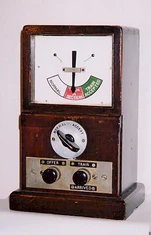 Tokenless Block method of working is the newest addition into Dovedale. It's offered itself as an alternative to Electric Token Block. It originated from the Western Region of the British Railway in 1967 on the line between Wilton and Pinhoe in Exeter. In essence it is similar to the Electric Token Block method, but the instrument itself is more akin to the Absolute Block instrument. It was designed for signallers in the western region whom, during the economy of that time, had to cover other duties that does not pertain exclusively to signalling. With this method of working, signallers are allowed to leave the block instrument on accepting, thus permitting them to leave the signal box to attend to other duties. Its main advantages are that there are no bell signals required, and less attention is required from the signaller. |
| 5.2 - Tokenless Block - Principle |
|---|
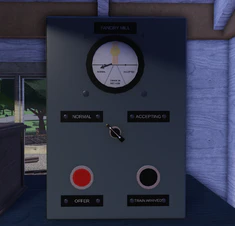 Like all other regulations/methods of working, its main principle is to have "one train, in one section, at one time". Tokenless Block however, like the name implies, does not require a token unlike the ETB system in the section above. What we have in Dovedale is based on the Tokenless Block Instrument for the BR Middle-eastern region. These consist of:
|
| 5.3 - Tokenless Block - Operation |
|---|
|
Tokenless block operation is largely different compared to other methods of working in game. Bell signals are not needed for this method of working. To offer a train, you must perform the following:
For ease of operation, Dovedale's TB Instruments have sounds in them that can be used as alerts similar to bell codes in other block instruments. If the accepting box's acceptance lever is not set to accepting, it will make a bell sound alerting them. Once their acceptance lever has been changed to accepting, the box that offered a train will be notified with a bell. Once the section signal is cleared and the train has passed it, the train will occupy a track circuit, causing both boxes' TB instruments to move to "Train In Section". When the train arrives at the receiving box it will activate a treadle and two track circuits in succession. (Anything else will cause the system to prevent Train Arrived from being pressed) If the train is complete with a tail lamp, the accepting box will then turn the acceptance lever to normal, before pressing Train Arrived to reset the block instrument to normal. When accepting, simply perform the actions of the accepting signal box above. If the offering box needs to cancel the train, the signaller must ask the accepting box to turn their block instrument to Normal then press Train Arrived to reset it. If the train despawns mid-section, the accepting signal box must turn their block instrument to Normal and press Train Arrived, then notify the offering signal box that the train has despawned. |
Operating Signals
| 6.1 - Clearing and Replacing Signals |
|---|
Clearing Stop SignalsBefore clearing a stop signal, you must ensure that:
Where the next stop signal is at danger, you must not clear a signal that cannot display a caution aspect until the train is nearly at a stand. This is to ensure that the driver's speed is controlled to stop at the next signal. Replacing Stop SignalsYou must replace a stop signal to danger as soon as the last vehicle of the trainset has passed the signal, and it has passed over all points facing to the movement. Clearing Distant SignalsBefore clearing a distant signal, you must ensure that all stop signals until the next distant signal or until the end of the section are set to clear. Replacing Distant SignalsYou must replace a distant signal to caution as soon as the train has passed the signal. Clearing Shunt SignalsYou should always attempt to clear all shunt signals required for the movement before allowing the driver to proceed. If you cannot clear all shunt signals, and you need to stop the train at an intermediate shunt signal, you should first advise the driver. |
| 6.2 - Passing Signals at Danger |
|---|
|
Before authorising a driver to pass a signal at danger, you must ensure that:
When passing a signal at danger, you must reach a clear understanding with the driver as to what move will occur. You must tell the driver:
You may then provide verbal authority to pass the signal, or provide a yellow handsignal. |
| 6.3 - Making Unsignalled Moves |
|---|
|
Before making an unsignalled move, you must ensure that:
You must reach a clear understanding with the driver as to what move will occur. You must then either:
|
| 6.4 - Signal Passed at Danger |
|---|
|
If a train has passed a signal at danger, or you have been made aware of a train heading towards your signal box without authority, you must:
|
Additional Resources
| 7.1 - Charts |
|---|
|
See the Charts page and the System Map for guides and maps on the game respectively. |
| 7.2 - Related Video |
|---|
|
British Rail Signalling Guide (UK) A real life signaller using the token machine, and setting points. (Singapore) A full explanatory video of how a token exchange works in real life. (Singapore) A full explanatory video of the entire token exchange system. (India) |
| 7.3 - Related Pages |
|---|
| 7.4 - Qualified Signaller Handbook |
|---|
|
For more infomation, find the Qualified Signaller Handbook here. |
References
